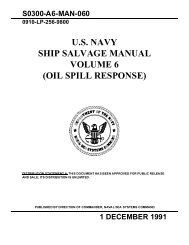U.S. NAVY SALVAGE REPORT DEEPWATER HORIZON ... - ESSM
U.S. NAVY SALVAGE REPORT DEEPWATER HORIZON ... - ESSM
U.S. NAVY SALVAGE REPORT DEEPWATER HORIZON ... - ESSM
Create successful ePaper yourself
Turn your PDF publications into a flip-book with our unique Google optimized e-Paper software.
Deepwater Horizon Oil Spill Response<br />
3-5 Funding Process<br />
As the operation progressed and funds were consumed, SUPSALV would notify the Unified Area<br />
Command when the balance was low, and additional funds were authorized to cover foreseeable<br />
future operations. Funding is summarized in Table 3-2.<br />
Date Amount Task<br />
02 May 2010 $ 3.5M Initial tasking<br />
21 May 2010 $ 3.75M Mod 2 – increased funds and extended duration<br />
18 June 2010 $ 5.5M Mod 3 – increased funds and extended duration<br />
02 July 2010 $ 0.138M Mod 4 – Requested support to test advanced skimming<br />
technologies<br />
21 July 2010 $ 8.524M Mod 5 – increase funds and extended duration<br />
Total: $ 21.412M<br />
Table 3-2. USCG Funding Authorization Dates and Amounts<br />
Funds provided used to replace equipment removed from service and determined to be beyond<br />
economical repair (BER) at the end of the operation are listed in Appendix B.<br />
3-6 Replacement of Items Beyond Economical Repair vs. Rental Rates<br />
Reimbursement for the operation was a subject of great discussion between Unified Area<br />
Command (UAC), the National Pollution Funds Center (NPFC), and SUPSALV from the<br />
beginning of the operation. Rental rates, based on a depreciation formula to capture<br />
recapitalization costs, are specifically allowed but not prescribed in Section VIII (c) of the<br />
Interagency Agreement (addressed in Section 3-1). In determining the applicability of rental<br />
rates, past practice was consulted. Typically, for smaller routine operations, the Navy had not<br />
charged rental rates to the Coast Guard. Rental rates were last used for the Exxon Valdez<br />
response, which was after the Interagency Agreement went into effect but predated OPA-90.<br />
Subsequently SUPSALV's practice has been to apply rental rates and charge non-government<br />
entities for use of SUPSALV equipment.<br />
By Mid-June the issue of rental rates and replenishment of items BER had not been resolved.<br />
On June 21, SUPSALV had been maintaining a rental rates spreadsheet and forwarded it to the<br />
Coast Guard requesting action. SUPSALV made the case that the existing funding Request for<br />
Assistance (RFA) and its modifications to support SUPSALV’s operation had been structured to<br />
support ongoing operational expenses and did not include recapitalization/depreciation of<br />
deployed gear. As of June 21, the rental rate charges were accumulating at a rate of $2M per<br />
week with a total of $16M accumulated to date. These figures were forwarded to the Coast<br />
Guard on 21 June requesting a funding document to provide separate funding for<br />
recapitalization.<br />
Over the following month negotiations resulted in a solution that allowed for documenting the<br />
condition of demobilized equipment and determination that the equipment was damaged BER.<br />
213RR forms were prepared for equipment identified as BER. This included: all 42” and 26” oil<br />
containment boom that had been in the water for greater than 60 days, all deployed NOFI<br />
Current Buster Vessel Skimming Systems, and a 50,000 gallon oil recovery bladder that had<br />
been damaged during decontamination. The UAC required an approved USCG inspector<br />
actually see the equipment SUPSALV claimed to be BER and concur with the assessment.<br />
3-3

















